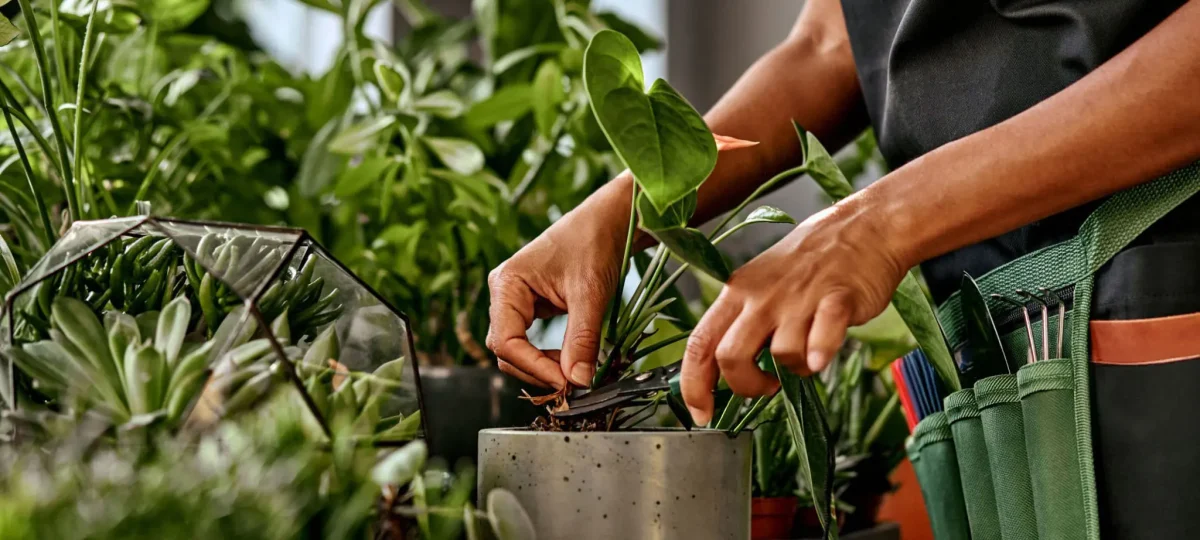Your air conditioner does much more than cool your air. If you follow our blog, you know that your air conditioner can also help you keep your home’s air quality high.
As long as you change your filter regularly, your air conditioner can strain dust and allergens out of the air before it cycles the cooled air through your home. Since air conditioners also remove humidity from the air, they cut down on the possibility of mold and mildew growth in your home.
You can rely on your air conditioner to keep you healthy — but if you take other small steps to clean your home’s air, your air conditioner won’t have to work as hard, and you can count on it to last for a decade or more without wearing out.
One simple way to improve your home’s air quality is helpful house plants. If you don’t have a green thumb, don’t worry. Most of the plants listed below thrive without a lot of oversight, but they still go a long way towards keeping your air clean and your family healthy.
How Do Houseplants Clean the Air?
Multiple scientists and academic institutions have gone to great lengths to demonstrate that houseplants can purify indoor air. In fact, in the 1980s, NASA commissioned a study to figure out if plants could help purify air in enclosed spaces — especially in space stations, which must recycle the same air over and over again.
NASA’s study — and other studies done in more recent decades — proved definitively that as houseplants absorb carbon dioxide, they also absorb harmful compounds that would otherwise find their way into your lungs. The oxygen that plants release is particulate-free.
The study of air in space stations benefits astronauts who need to breathe clean air in space, but it also helps regular homeowners here on earth. Houseplants and Air Conditioning Working Together.
What Do Houseplants Remove From the Air?
Your air conditioner’s filter removes dirt, debris, pollen, smoke, and other pollutants from the air. Houseplants help by removing several harmful compounds that HEPA filters also filter out, including:
- Formaldehyde, a toxin found in paper towels, paper bags, and plywood, as well as some anti-wrinkle, waterproof, or antistatic fabrics
- Ammonia, a toxin found in glass cleaners (like Windex), fertilizer, and some floor waxes
- Benzene, a toxin found in tobacco smoke, paint, glue, detergent, and furniture waves
These three represent some of the most dangerous chemicals in your air, and they can be hard to eliminate. You can keep them out of your air by reducing your reliance on products, such as ammonia-based glass cleaners and paper towels, but plants can partner with you to reduce your exposure to dangerous chemicals.
Plant any of the following houseplants to keep your air clean and cut down on the amount of particles your air filter has to remove.
- Spider Plants
In spite of their scary name, these plants are pretty and easy to take care of. As long as you keep it in a spot with lots of indirect sunlight and don’t overwater the plant, you won’t have a hard time keeping it alive.
Every spring, your indoor spider plant should produce small, white flowers that eventually turn into miniature versions of the mother plant. You can remove these offshoots and plant them to grow even more easy-to-care-for, air-filtering plants. Houseplants and Air Conditioning Working Together.
- Bamboo Palms
Bamboo palms don’t need much care to flourish. You only need to water the plant every once in a while; overwatering can kill it. These palms also need indirect but bright sunlight, and they thrive particularly well in humid climates with moderate to high temperatures.
In spite of their name, bamboo palms aren’t from the same family as the bamboo we use to make furniture. Instead, they’re from a grass family, which means you can expect the plant to stay leafy and green all year long.
- Flamingo Lilies
Flamingo lilies get their name from their vividly red flowers. Like the other two plants we’ve listed, flamingo lilies should be placed in indirect sunlight and, preferably, in higher humidity levels. If you don’t live in a humid climate, you can increase humidity levels directly around the plant by placing an aquarium nearby, using a small humidifier, or planting moss around the lily. Houseplants and Air Conditioning Working Together.
- Kimberly Queen Ferns
You might also hear Kimberly queen ferns referred to as sword ferns because they have thin, straight, bright green fronds. They usually grow around three feet tall. As long as you maintain a higher humidity level around the fern, you can place it in direct sunlight, but make sure the sun doesn’t dry out the soil too much.
Enjoy Your Home’s Clean Air
When your houseplants work together with your air conditioner, you can rest easy knowing that you’re only breathing in clean, clear air at home.
If you need help with your air conditioner or want to upgrade your filter, get in touch with our company. We’re happy to help keep your family’s air clean!


